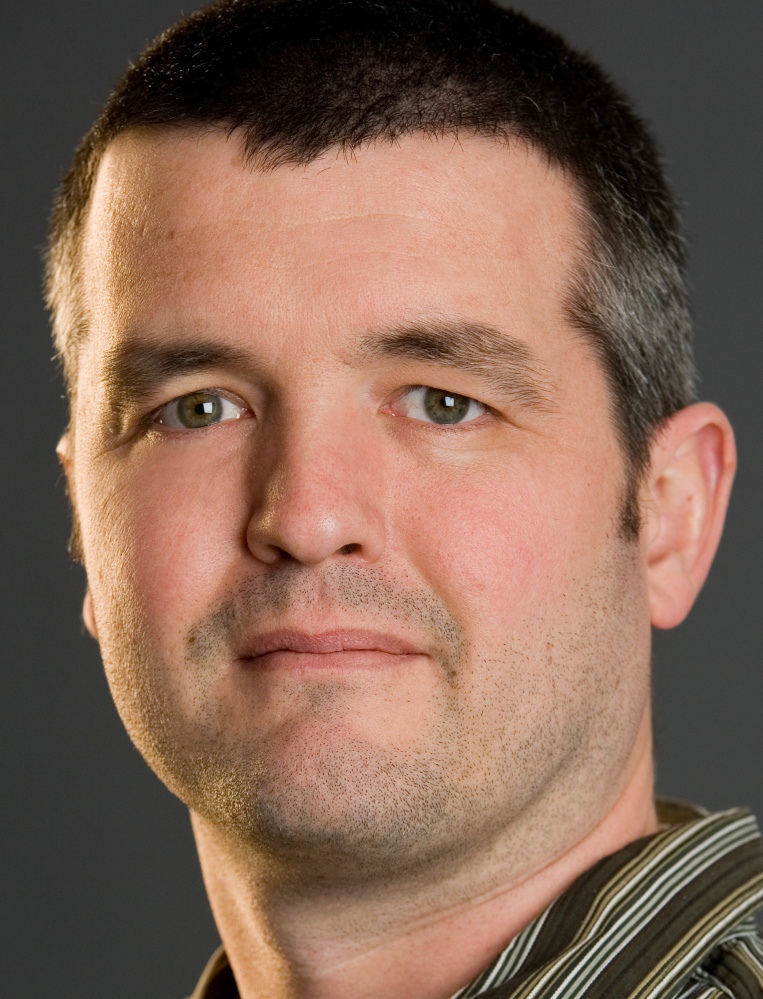Things got a little hairy during the making of the new Disney film “Pete’s Dragon,” and visual effects supervisor Eric Saindon is very proud of that.
The 46-year-old Gorham native says the 20 million individual hairs covering the computer-animated dragon shows how far film animation has come in the effort to simulate reality.
When Saindon worked on “King Kong” in 2005, the giant gorilla was covered in 1 million hairs. “That’s as far as we could go then,” Saindon said. “But now we can get a crazy amount of detail in everything. This dragon has more than 20 million hairs, all simulated to act properly in wind, rain, whatever happens to them.”
Saindon headed a crew of 300 visual effects creators, who computer-animated the dragon in 600 shots of the film, with each shot containing about 100 frames. Animators didn’t simply draw a giant, furry green dragon in each of those frames, as a Disney artist of the 1950s might. They built the dragon from the inside out, one hair, one muscle, one eyelash at a time.
The film, which is due in theaters Friday, is a remake of a 1977 musical that featured singer Helen Reddy, Mickey Rooney, Red Buttons and Shelley Winters. That film featured a green cartoon dragon interacting with the live actors. The current film is a drama/adventure focusing on a young boy named Pete, who lived in the woods of the Pacific Northwest for six years with a mysterious dragon named Elliot, before being found by a forest ranger. But when adults find out about Elliot, they plot to capture him. The movie stars Bryce Dallas Howard, daughter of actor/director Ron Howard, as the forest ranger, Robert Redford as her father, and Oakes Fegley as Pete.
The new Elliot doesn’t look like a cartoon. Trailers for the film show him blending in with the actors and the real scenery. To achieve that level of realism in a computer-animated character takes not only artistic and computer skills, but a fairly deep knowledge of science. So Saindon’s crew of effects creators at Weta Digital – the New Zealand effects studio founded by director Peter Jackson – includes people with backgrounds in biology and anatomy. Before Elliot the dragon could be created, a lot of research was done in how cats and dogs move and interact with people, Saindon said, to accurately simulate the dragon’s relationship with Pete.
“They studied the way a dog nuzzles someone’s leg, or the way a cat turns and circles on a bed before lying down,” said Saindon, from his home in Wellington, New Zealand. “We wanted Elliot to seem like a familiar character, even though he’s a 22-foot, furry green dragon.”

Oakes Fegley is Pete in Disney’s “Pete’s Dragon,” the story of a boy named Pete and his best friend Elliot, who just happens to be a dragon. Photo courtesy of Disney
To get the needed emotion in Elliot’s face, computer animators built his face one muscle at a time.
Saindon said the animators started by building a skeleton of the dragon, including his face, in the computer. Then they filled the skeleton with muscles, all simulated to act like actual muscles. So when Elliot smiles, or winks his eye, the muscles used to do that react like real muscles and change the shape of his face accordingly.
“We don’t want just a drawn smile. We want sliding skin and whatever else happens when someone smiles,” said Saindon. “It’s hard to explain 3D in a 2D world, but it’s like we’re building volume, like filling water balloons, but in the computer.”
This kind of detail is found not only in creatures, but in natural events that are animated too. When his crew animates a fire in the movie, Saindon said, they simulate the fuel, the ignition source and all the other elements of a fire, so it will burn realistically.
As visual effects supervisor, Saindon oversaw the various teams of effects creators and looked at all the work being done every day. He also spent time on the phone with Disney, telling studio officials about each shot, including which are ready to go into the film.

Oona Laurence is Natalie and Oakes Fegley is Pete in “Pete’s Dragon,” which opens Friday. Photo courtesy of Disney
When Saindon started at Weta 17 years ago, he was on the team that created animated puppets, including those for the “Lord of the Rings” and “Hobbit” movies. Saindon studied architecture at Washington State University and later got a job at a company that made animation software. That led to his career in creating effects for films.
As a visual effects supervisor, he’s been nominated for an Oscar twice, for “The Hobbit: The Desolation of Smaug” in 2014 and “The Hobbit: An Unexpected Journey” in 2013.
Saindon says he’s not supposed to give away the plot of “Pete’s Dragon,” but he did learn that the original 1977 musical was set in Maine, though not filmed here. That film was set in the fictional town of Passamaquoddy, the name for which screenwriter Malcolm Marmorstein saw on a map, as Passamaquoddy Bay on the Canadian border, and found he liked the sound of it. The credits for the new version say the story is based on Marmorstein’s screenplay. Contacted at his home in Hollywood, Marmorstein, 87, said he didn’t know why the setting was changed in the latest film to the Pacific Northwest.
But just as Marmorstein used a real Maine name in his script, Maine-born Saindon wants the animated characters he helps makes with 21st-century technology to be as real as possible.
“Explaining what we do can sound over-complicated, but we’re trying to use what we have to completely mimic reality,” said Saindon. “I’ve been doing this for 17 years, and I still learn something new every day.”
Send questions/comments to the editors.




Comments are no longer available on this story